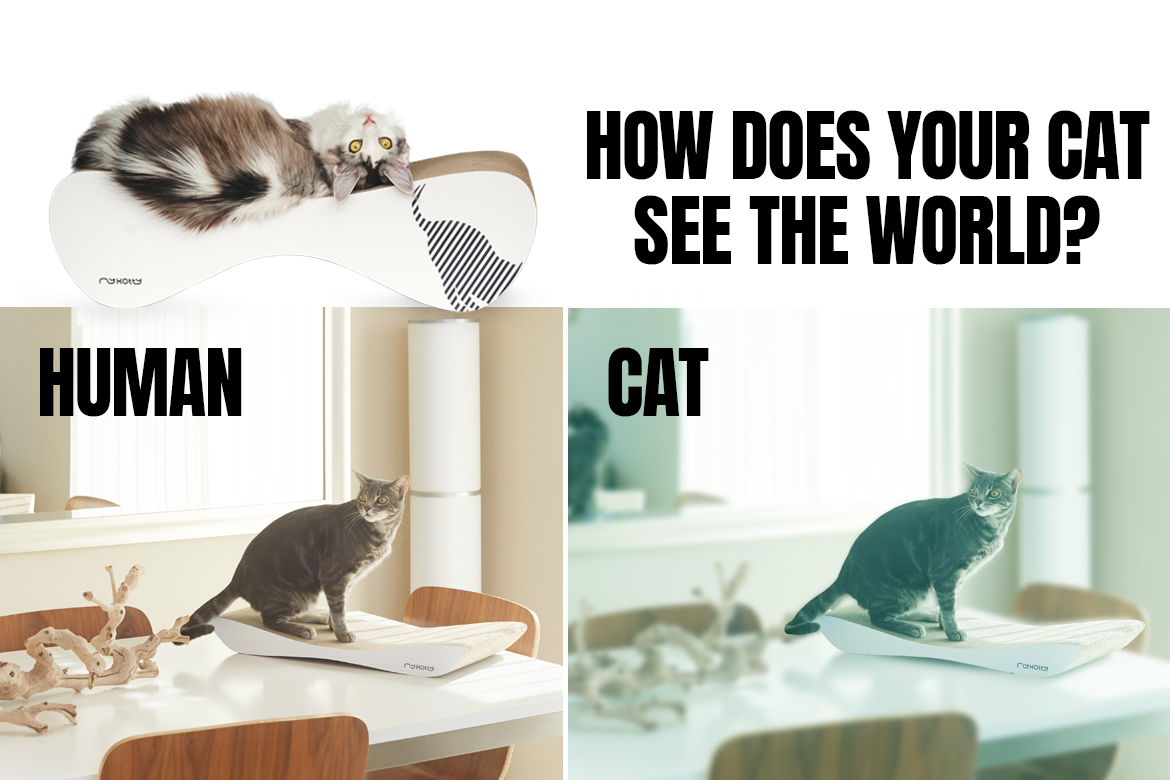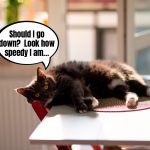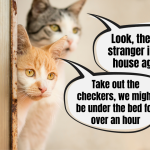How many minutes will a fly survive at your house before it gets noticed and hunted down by the cat? A few moments? Couple of minutes? An entire day? We’re betting it’s the shortest time possible – after years of living with cats by our side we’re sure that when it comes to flying bugs, they have a built-in super radar. But what exactly draws their attention? The buzzing sound of a fly, or maybe the movement of a black spot on a white-wall background seen out of the corner of the eye? Cat’s senses are working in perfect harmony the entire day (even during naps!), but today we’re focusing on the eyes and observing the world from the cat’s perspective. What interesting things will we see?
Cats’ colorful world
You surely know stories about cats seeing only in black and white. Similar myths surround many other animals, e.g. dogs. Recent studies about the cat’s world and seeing it from the cat’s perspective show that our black and white assumptions were completely wrong. Cats can see color and can get a lot of information from it. Their color recognition capabilities are limited compared to humans, but both in nature and at-home environments, cat’s sight does its job with the highest efficiency.
Cat’s eyes can register three main colors – green, yellow and bluish-purple shades. There’s no red in that package, which means for cats red objects look like different hues of yellow. From yours, their fabCat Guardians perspective, this might be quite useful, knowing that bright yellow toys with red elements won’t be as striking for a cat as they are for us. This partial “daltonism”, if we were to call it that, does not inhibit, in any way, a cat’s ability to observe their environment.
Cats – the masters of nighttime walks
Thinking about cat’s sight you’ll definitely get the image of a cat sneaking through the night into the kitchen and effortlessly navigating the nighttime scene without any risk of bumping into toys that are scattered around on the floor. In reality cats’ abilities to see at night are not that obvious. It’s true that, compared to humans, cats have developed a much better ability to move around at night. However, it’s all thanks to their specific eye structure and a reflective membrane (tapetum lucidum) which catches the light and reflects it, making it easier to see in low light. That’s where the probability of us stomping on a sharp as a knife LEGO piece is much higher than for a cat. 🙂
Cats can’t see in complete, “egyptian” darkness, but only in places where there’s at least a small amount of light. Their sight isn’t perfect then, either – the view is black and white and blurred, but it’s enough to avoid obstacles, toy mice, water bowls and scratchers set around the floor. No wonder cats look at us like we’re the biggest butterfingers every time we trip over something on our way to the toilet at 3 am.
Come closer and you’ll get caught
Let’s get back to the fly we’ve caught at the beginning. Does the cat see it out of the corner of their eye and think it’s definitely a tasty snack? Not necessarily. The sharpness of the image they see is definitely worse than for humans and the central point is smaller than ours. Cats see a slightly blurred image except the point they’re focusing on at the moment. At the same time, their angle of sight is much wider than ours and seeing out of the corner of their eye is actually a great party trick. Even if we want to sneak past a cat’s bed, our alert kitty will see us with no issues.
It’s also important to take a note of one curious tidbit that could bring your cat playtime skills to a whole new level. According to researchers that have studied cats and their sight, cats see better when the objects around them are moving fast – a fly under the ceiling is much more appealing and attractive than a slow moving string that you want to get your cat’s attention with. Another important thing is that cats see sharp images only for the things that are close to them (up to about 6 meters) – they’re not far sighted. A fly on the ceiling would be in their perfect sight range. Things get blurry though if they’re just under the cat’s nose.
Working with all the senses
The amazing work of the cat’s eyes deserves a medal – despite some limitations compared to what humans see, cat’s senses are purrfectly fit for their hunting lifestyle. Why would they even need to see the red colour if it’s much more vital for the survival of the species to simply catch the best prey in the neighbourhood? For a cat, their color has little to no significance.
Now we have reached a point where we have to see a cat as a complex being – see their organisms as the greatest national team in the Olympics. The sight is a medalist in its own discipline, but it won’t be a colossal success without equally wonderful starts from all the other athlete senses. Smell and hearing are constantly supporting the sight. This information may be surprising to some – after all, it’s dogs who have always been considered the greatest sniffers. In the meantime cats, lazy and patient, besides observing the world with their eyes, rely on their hearing and smells while hunting. For us and you, dear fabCats, it shouldn’t be a surprise though. We all know well that cats can smell the best stuff on the market hidden inside our Kung Fu cat toy from a mile away.
Are you wondering sometimes, fabCats, what it is that your cats see looking at a seemingly blank wall? Or how exactly can they see a spider walking down the railing, when it’s so small it’s nearly invisible? Equipped with a fresh portion of cat tidbits you can certainly interpret the way cats see the world a little bit better. Be sure to let us know which ones were the most surprising for you and tell us in the comments if any other fun facts about cat’s sight have recently caught your eye!




